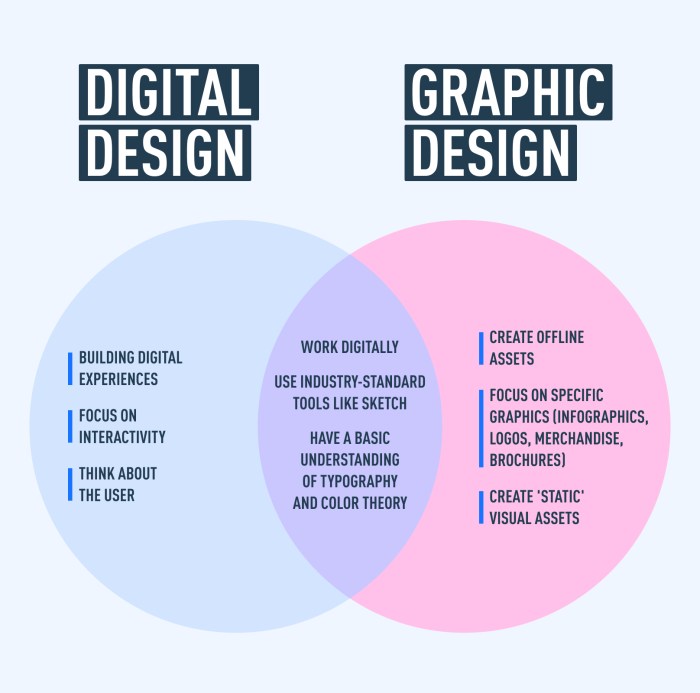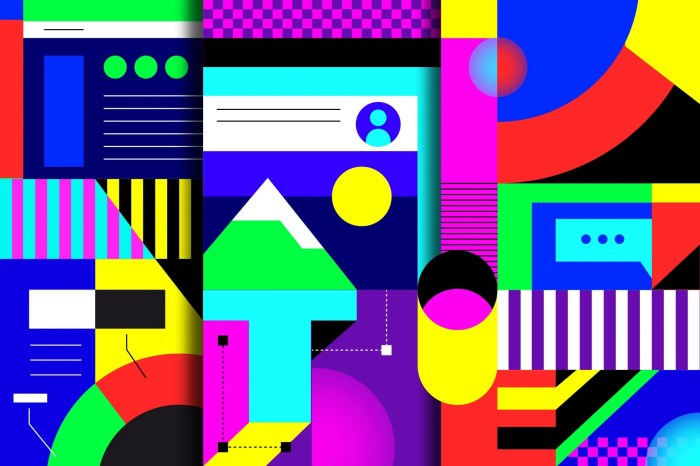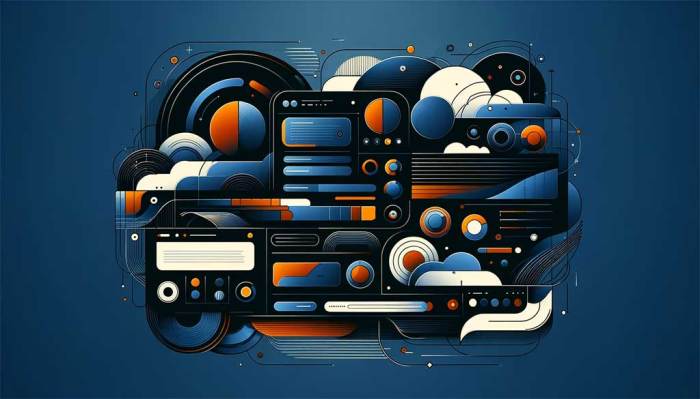Crafting Digital Design: Enhancing User Experience and Branding
As digital design takes center stage, this opening passage beckons readers into a world crafted with good knowledge, ensuring a reading experience that is both absorbing and distinctly original. From impacting user experience to defining brand identity, digital design plays a crucial role in shaping the online landscape.
Let's delve into the key aspects that make digital design a vital component of modern aesthetics and functionality.
Importance of Digital Design
Digital design plays a crucial role in shaping the user experience of websites, apps, and other digital platforms. It encompasses the visual elements, layout, and interactive features that enhance usability and engagement for visitors.
Impact on User Experience
Digital design directly impacts user experience by creating intuitive interfaces, clear navigation paths, and visually appealing layouts. A well-designed website or app can guide users seamlessly through the content, making it easy for them to find what they are looking for.
This leads to higher user satisfaction and increased engagement with the platform.
Role in Branding
Digital design is essential for branding as it helps convey the values, personality, and identity of a brand to the audience. Consistent use of colors, typography, and visual elements across digital platforms creates a strong brand image and reinforces brand recognition.
A cohesive and visually appealing design can leave a lasting impression on users and build trust in the brand.
Significance of Responsive Design
Responsive design is crucial in today's digital landscape where users access websites and apps from various devices with different screen sizes. A responsive design ensures that the content adapts and displays correctly on any device, providing a seamless user experience.
It not only improves usability but also boosts search engine rankings as search engines prioritize mobile-friendly websites. In a mobile-first world, responsive design is no longer a choice but a necessity for digital success.
Elements of Digital Design
Typography, color theory, layout, visual hierarchy, imagery, and graphics are key elements that play a crucial role in digital design. Each element contributes to creating visually appealing and functional digital products.
Typography
Typography involves the selection and arrangement of fonts in design. It is essential for conveying the tone and message of the content. The right typography can enhance readability and user experience.
Color Theory
Color theory is the study of how colors interact with each other. It helps in creating visual harmony and conveying emotions or messages effectively. Understanding color psychology is crucial in digital design to evoke specific feelings or actions from users.
Layout
Layout refers to the arrangement of elements on a digital interface. A well-structured layout can improve the overall user experience by guiding the user's attention and facilitating navigation. It also helps in organizing content in a clear and intuitive manner.
Visual Hierarchy
Visual hierarchy is the arrangement of elements in a way that establishes an order of importance. By using varying sizes, colors, and placement, designers can guide users' focus and prioritize information effectively. It ensures that users can easily navigate through the content and understand the message being communicated.
Imagery and Graphics
Imagery and graphics are powerful tools in digital design for enhancing visual appeal and conveying information. They can create engaging visual experiences, evoke emotions, and communicate complex ideas effectively. Using high-quality images and graphics can significantly improve the overall aesthetics of a digital product.
Tools and Software for Digital Design

When it comes to digital design, having the right tools and software can make a significant difference in the creative process. There are several popular options available that cater to different aspects of design, ranging from graphic design to UI/UX and web design.
Popular Tools for Digital Design
- Adobe Creative Suite: Adobe offers a comprehensive suite of tools like Photoshop, Illustrator, and InDesign, which are widely used for graphic design and digital art.
- Sketch: Sketch is a popular vector graphics editor specifically designed for UI/UX design, known for its ease of use and powerful features.
- Figma: Figma is a cloud-based design tool that is gaining popularity for its collaborative features, making it ideal for team projects and UI/UX design.
- Adobe XD: Adobe XD is another tool for UI/UX design that allows designers to create interactive prototypes and wireframes seamlessly.
Comparison of Software Options
When comparing software options for graphic design, UI/UX, and web design, it's essential to consider factors like user interface, features, pricing, and compatibility. Each tool has its strengths and weaknesses, so choosing the right one depends on the specific needs of the project and the designer's preferences.
Impact of Design Tools on the Creative Process
The design tools used can significantly impact the creative process by influencing the designer's workflow, efficiency, and ability to bring ideas to life. Intuitive tools with advanced features can streamline the design process and enhance collaboration, leading to more innovative and visually appealing outcomes.
Trends in Digital Design
Digital design is constantly evolving, with new trends shaping the way we interact with websites, apps, and other digital interfaces. Let's delve into some of the current trends in digital design that are influencing the way designers create engaging user experiences.
Dark Mode
Dark mode has gained popularity in recent years, offering users a sleek and modern interface that is easier on the eyes, especially in low-light environments
3D Elements
The use of 3D elements in digital design adds depth and realism to interfaces, creating visually stunning experiences for users. From 3D illustrations to interactive 3D models, this trend is transforming the way designers bring their concepts to life and engage users in a more immersive way.
Micro-interactions
Micro-interactions refer to small animations or visual cues that provide feedback to users when they interact with a digital interface. These subtle animations, such as button hover effects or loading animations, enhance user engagement and create a more dynamic user experience.
Designers are leveraging micro-interactions to make interfaces more intuitive and engaging for users.
Influence of Minimalism and Flat Design
Minimalism and flat design have had a significant impact on modern digital interfaces, emphasizing simplicity, clarity, and usability. By removing unnecessary elements and focusing on clean, minimalist aesthetics, designers are able to create visually appealing interfaces that are easy to navigate and understand.
This design approach has become a staple in digital design, shaping the way users interact with websites and applications.
Animation and Motion Graphics
Animation and motion graphics play a vital role in transforming digital design by adding movement and interactivity to static interfaces. From animated illustrations to complex transitions, designers are using animation to create engaging and memorable user experiences. Motion graphics, such as loading animations and video backgrounds, are also being used to convey information and captivate users in a more dynamic way.
User-Centered Design in Digital Design

User-centered design is an approach that prioritizes the needs and preferences of the end-user throughout the design process. By focusing on creating products or interfaces that are intuitive, easy to use, and enjoyable for the user, this design philosophy aims to enhance user satisfaction and overall usability.
Importance of User-Centered Design
User-centered design is crucial in digital design as it ensures that the final product meets the needs and expectations of the target audience. By conducting user research and incorporating feedback into the design process, designers can create solutions that are tailored to the users' preferences, resulting in higher user engagement and satisfaction.
- Improves user satisfaction: By understanding the users' needs and preferences, designers can create interfaces that are user-friendly and intuitive, leading to higher satisfaction levels.
- Enhances usability: User-centered design focuses on making products easy to use, reducing the learning curve for users and increasing efficiency.
- Reduces errors and confusion: By considering how users interact with the product, designers can identify potential pain points and address them proactively, reducing errors and confusion.
Examples of User Research in Digital Design
User research informs digital design decisions in various ways, such as conducting surveys, interviews, usability testing, and analyzing user behavior data. For instance, analyzing heatmaps and click-through rates can help designers identify areas of improvement in the user interface, leading to a more user-friendly design.
- Survey feedback: Gathering feedback through surveys can provide valuable insights into users' preferences, pain points, and expectations, guiding design decisions.
- Usability testing: Observing users interact with prototypes can help designers identify usability issues and make necessary adjustments to improve the overall user experience.
- Persona development: Creating user personas based on research findings can help designers empathize with the target audience and design solutions that meet their specific needs.
Best Practices for Intuitive User Interfaces
Designing intuitive user interfaces based on user-centered design principles involves simplifying the user experience and making interactions seamless and easy to understand. Some best practices include:
- Consistent navigation: Maintain a consistent layout and navigation structure throughout the interface to help users easily find what they are looking for.
- Clear hierarchy: Use visual hierarchy to prioritize important information and guide users' attention to key elements on the screen.
- Accessible design: Ensure that the design is accessible to all users, including those with disabilities, by following web accessibility guidelines.
Closing Notes

In conclusion, digital design is more than just pixels on a screen—it's a dynamic tool that can elevate user interactions and establish a lasting brand presence. By considering the elements, tools, trends, and user-centered approaches discussed, designers can create immersive digital experiences that resonate with audiences.
Embrace the ever-evolving world of digital design, where creativity knows no bounds.
Questions and Answers
How does digital design impact user experience?
Digital design influences user experience by creating intuitive interfaces, visually appealing layouts, and seamless interactions.
What is the role of digital design in branding?
Digital design helps define brand identity through visual elements, establishing a recognizable and consistent brand image across platforms.
Why is responsive design significant in digital platforms?
Responsive design ensures optimal viewing experiences across different devices, enhancing accessibility and user engagement.
How do design tools impact the creative process?
Design tools streamline workflows, enhance collaboration, and provide designers with the necessary resources to bring their creative visions to life.
What are some current trends in digital design?
Current trends include dark mode themes, 3D elements, micro-interactions, minimalism, flat design, and the integration of animation and motion graphics.




